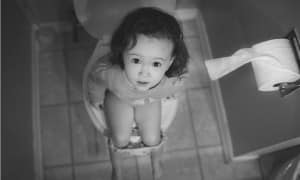Some young girls’ vulva labia minora will appear to be completely closed. This is called fused labia or labial adhesion. This causes stress for parents who had no idea it could occur before seeing it. Can she urinate? Is it permanent? Is it dangerous? Why does it happen? What do parents need to do? I can understand why parents have many questions!
A young baby girl’s labia are thin, delicate and surround the vaginal and urethral (to urinate) openings. The fusion of the labia frequently occurs between 4 months and 6 years of age, and peaks at around 2-4 years. The situation is not irreversible. This complete adhesion means that nothing is visible inside the vagina (labia majora and clitoris). It doesn’t cause pain, is benign and asymptomatic (no symptoms) for the baby or child, and occurs gradually. When seeing a doctor or nurse, they may observe signs that fusion is slowly happening. Frequently it’s the parents that note the modification when changing a diaper or cleaning their genital region. They will then talk to their doctor about it.
 If symptoms such as outbreaks, itching occur, this is due to another cause as it is not associated with labial fusion.
If symptoms such as outbreaks, itching occur, this is due to another cause as it is not associated with labial fusion.
Very rarely this fusion will prevent urination, though sometimes the urine may deviate. In general, fusion does not cause vulva or urinary infections.
What causes labial fusion?
Labial fusion occurs in young girls because they don’t have estrogen, which prevents adhesion. This rarely happens in babies under 3 months, given that they still have residual estrogen transmitted from their mother during pregnancy.
Given that the labial skin is thin and delicate, there is a higher risk of adhesion. Frequently this will disappear without treatment when girls reach puberty as they start gradually producing hormones.
During my practice, I also noted that this frequently occurred in chubbier babies, but it doesn’t happen only to them. Additionally, the moist environment of the diaper predisposes this condition.
How do you deal with labial fusion?
In most cases, the problem takes care of itself and doesn’t require treatment or procedures. It will fully heal on its own as the girl grows and starts releasing hormones.
Frequently caregivers will suggest applying a fatty substance, such an ointment (zinc cream or Vaseline) on the labia to prevent them adhering to each other.
If their ability to urinate is affected, the doctor will prescribe an estrogen hormone-based cream to separate the labia, free up the urinary meatus and prevent a future fusion. During the visit, they will show you how to apply the ointment to the fusion. You should see results in a couple of days for a young baby and a couple of weeks for older children.
Monitoring is required because you cannot apply a prescribed cream indefinitely and to avoid relapses.
Never pull on the edges of the labia to separate them as it will cause pain and lead to your daughter, keeping a negative and traumatic association.
Operating on a child for labial fusion is very rare, but it can occur for more severe cases. The procedure takes place under general anesthesia.
I hope this article about labial fusion has shown that it occurs more frequently than we think, and as parents of a young daughter, you can be less worried if this happens to your baby.
Talk soon,
Marie
The Baby Expert


